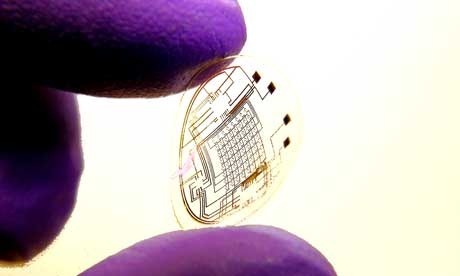Derren Brown's Blog, page 11
November 30, 2011
'Harry Potter and yoga are evil', says Catholic Church exorcist
"Father Gabriele Amorth, who for years was the Vatican's chief exorcist and claims to have cleansed hundreds of people of evil spirits, said yoga is Satanic because it leads to a worship of Hinduism and "all eastern religions are based on a false belief in reincarnation".
Reading JK Rowling's Harry Potter books is no less dangerous, said the 86-year-old priest, who is the honorary president for life of the International Association of Exorcists, which he founded in 1990, and whose favourite film is the 1973 horror classic, The Exorcist.
The Harry Potter books, which have sold millions of copies worldwide, "seem innocuous" but in fact encourage children to believe in black magic and wizardry, Father Amorth said.
"Practising yoga is Satanic, it leads to evil just like reading Harry Potter," he told a film festival in Umbria this week, where he was invited to introduce The Rite, a film about exorcism starring Sir Anthony Hopkins as a Jesuit priest.
"In Harry Potter the Devil acts in a crafty and covert manner, under the guise of extraordinary powers, magic spells and curses," said the priest, who in 1986 was appointed the chief exorcist for the Diocese of Rome.
"Satan is always hidden and what he most wants is for us not to believe in his existence. He studies every one of us and our tendencies towards good and evil, and then he offers temptations." Science was incapable of explaining evil, said Father Amorth, who has written two books on his experiences as an exorcist. "It's not worth a jot."
Read more at The Telegraph (Thanks Annette)
November 29, 2011
Popping a multivitamin can lead to debauchery

"Taking supplements may lead to poorer health, not because of what they do to your body, but what they do to your mind.
When people take supplements they get a false sense of invulnerability, a new study shows. And that can translate into a greater tendency to head down the path of risky behavior.
The intriguing study published in Psychological Science, found that people didn't even need to be given real supplements for this devil-may-care attitude to develop – they just needed to be told they were swallowing something healthful.
For their study, Taiwanese researchers gave placebo pills to 82 volunteers, half of whom were told the capsules contained vitamins. The rest were told the truth – that these were simply sugar pills.
The big surprise came when the researchers surveyed the two groups. Those taking phony supplements reported a greater sense of invulnerability and less of a desire to exercise. They also were more likely to consider engaging in casual sex, sunbathing and binge-drinking.
At the end of the study the two groups were told they could choose between a healthful meal and an all-you-can-eat buffet. Sure enough, more of those in the group who were told they'd taken a supplement said they'd prefer the buffet."
Read more at MSNBC (Thanks Annette)
November 28, 2011
Alan Moore – meet the man behind the protest mask

"The comic-book writer Alan Moore is not usually surprised when his creations find a life for themselves away from the printed page. Strips he penned in the 1980s and 90s have been fed through the Hollywood patty-maker, never to his great satisfaction, resulting in both critical hits and terrible flops; fads for T-shirts, badges and shouted slogans have emerged from characters and conceits he has dreamed up for titles such as Watchmen and From Hell. "I suppose I've gotten used to the fact," says the 58-year-old, "that some of my fictions percolate out into the material world."
But Moore has been caught off-guard in recent years, and particularly in 2011, by the inescapable presence of a certain mask being worn at protests around the world. A sallow, smirking likeness of Guy Fawkes – created by Moore and the artist David Lloyd for their 1982 series V for Vendetta. It has a confused lineage, this mask: the plastic replica that thousands of demonstrators have been wearing is actually a bit of tie-in merchandise from the film version of V for Vendetta, a Joel Silver production made (quite badly) in 2006. Nevertheless, at the disparate Occupy sit-ins this year – in New York, Moscow, Rio, Rome and elsewhere – as well as the repeated anti-government actions in Athens and the gatherings outside G20 and G8 conferences in London and L'Aquila in 2009, the V for Vendetta mask has been a fixture. Julian Assange recently stepped out wearing one, and last week there was a sort of official embalmment of the mask as a symbol of popular feeling when Shepard Fairey altered his famous "Hope" image of Barack Obama to portray a protester wearing one.
It all comes back to Moore – a private man with knotty greying hair and a magnificent beard, who prefers to live without an internet connection and who has not had a working telly for months "on an obscure point of principle" about the digital signal in his hometown of Northampton. He has never yet properly commented on the Vendetta mask phenomenon, and speaking on the phone from his home, Moore seems variously baffled, tickled, roused and quite pleased that his creation has become such a prominent emblem of modern activism.
"I suppose when I was writing V for Vendetta I would in my secret heart of hearts have thought: wouldn't it be great if these ideas actually made an impact? So when you start to see that idle fantasy intrude on the regular world… It's peculiar. It feels like a character I created 30 years ago has somehow escaped the realm of fiction.""
Read more at The Guardian (Thanks @JoJoe69369)
November 26, 2011
Would you wear a bionic contact lens to read emails?

"Fans of the Terminator franchise may be thrilled but others may be confused over just what a bionic contact lens adds to humanity. According to the developers at Washington University, users could view floating emails and text messages as well as augment their sight with computer-generated images. They say it has been successfully tested on animals (presumably those with email accounts) and when problems such as finding a decent power source are ironed out it could be ready for market.
Is this what the world has been waiting for – or is technology bringing us a load of pointless new kit? What, given a top team of boffins and a whopping budget, would be the innovation of the future you'd like to see?"
Via Guardian (Thanks Annette)
November 25, 2011
Humanists launch "Naughty" awareness campaign
"This week, the American Humanist Association announced the launch of their holiday advertisement campaign aimed to raise awareness of discrimination against nonbelievers in America.
The billboards and full-page newspaper ads contain the message, "Bias Against Atheists is Naughty, Not Nice," and features Santa Claus making up his "naughty" list. The ads are placed in cities across the United States where atheists have experienced discrimination due to their lack of belief in a traditional god.
"Nonbelievers in America continue to be the object of discrimination," said Roy Speckhardt, executive director of the American Humanist Association. "We hope this campaign will spur a conversation about this problem that moves us in a positive direction."
Speckhardt continued, "Many humanists and atheists in America experience hatred in their own communities when simply standing up for the separation of church and state, or fighting for other rights that should be afforded without question."
For example, the AHA placed an ad in the Cranston Herald newspaper because a high school student, Jessica Ahlquist, endured harassment and threats—one even called her a "stupid atheist"—for objecting to the display of a religious prayer banner hanging in her public high school auditorium.
Another ad was placed in a newspaper near Bastrop, Louisiana, where a student named Damon Fowler was ostracized by his community—even his own parents kicked him out of his home—for objecting to a Christian prayer that would be held during his graduation ceremony."
Read more at Secular News Daily (Thanks Annette)
November 24, 2011
Robot Paints Its Feelings
Interactive Robotic Painting Machine (2011) from benjamin grosser on Vimeo.
"Artist and composer Ben Grosser, who is working on an MFA in New Media at the University of Illinois, has developed a robot that's able to hear the world around it and use those sounds to create a painting.
The Interactive Robotic Painting Machine has a microphone that captures surrounding sound and a genetic algorithm designed to transform those sounds into computer code ultimately drives the robot's paintbrush in three dimensions, controlling how much paint to put on the brush and how much pressure to apply to canvass.
The sounds can come from people in the room or, when people aren't around, can come from the machine itself. In a related project called HeadSwap, the robotic painter collaborated with violinist Benjamin Sung, who played music composed by Zack Browning. At the same time that Sung was watching the machine paint and using what he saw to inform his music, the machine was listening to Sung play and using that to inform its art.
On his website, Ben says, "It is important to understand that what the machine paints is not a direct mapping of what it hears. Instead, the system is making its own decisions about what it does while being influenced by others.""
Via Discovery News (Thanks Annette)
November 23, 2011
Reframing Emotions to Avoid Stress
"By taking the approach that it is not about you – that an angry person is just having a bad day — you may be able to stave off bad feelings and emotional stress. It's a common strategy.
For example, you might tell yourself that they've probably just lost their dog or gotten a cancer diagnosis and are taking it out on you. This technique is termed emotional reappraisal, a common strategy used in cognitive-behavioral therapy.
A new study, to be published in an upcoming issue of Psychological Science, reviews the concept and suggests areas for future investigation.
Stanford researchers led by Jens Blechert wanted to study the efficiency and speed of reappraising emotions.
Emotions develop in the front part of the brain and move backward in the brain as they are processed. On the other hand, the emotional reappraisal process begins in the back of the brain and moves forward.
"You can see this as a kind of race between the emotional information and the reappraisal information in the brain: Emotional processing proceeds from the back to the front of the brain, and the reappraisal is generated in the front of the brain and proceeds toward the back of the brain where it modifies emotional processing," Blechert said.
Blechert and his colleagues came up with two experiments to study this process. Participants were shown several series of faces and tested on their reactions.
For example, in one set, they were told to consider that the people they'd seen had had a bad day, but it's nothing to do you with you.
"So we trained the participants a little bit, not to take this emotion personally, but directed at someone else," Blechert said.
They found that once people had adjusted their attitude toward someone, they weren't disturbed by that person's angry face the next time it appeared.
On the other hand, when participants were told to just feel the emotions brought on by an angry face, they continued to be upset by that face.
A different study used an intriguing approach as researchers recorded electrical brain activity from the scalp and found that reappraising wiped out the signals of the negative emotions people felt when they just looked at the faces.
The findings are significant as psychologists used to think that people had to feel the negative emotion, and then get rid of it.
If these findings are confirmed, the process is actually a much faster and deeper process – given that the people are prepared.
"If you're trained with reappraisal, and you know your boss is frequently in a bad mood, you can prepare yourself to go into a meeting," said Blechert. "He can scream and yell and shout but there'll be nothing [that you feel]."
Continued testing of this hypothesis is required as this study only looked at still pictures of angry faces. In his next experiment, Blechert would like to test how people respond to a video of someone yelling at them."
Via PsychCentral (Thanks Berber)
November 22, 2011
Scientists Develop World's Lightest Metal, 100x Lighter than Styrofoam

"This, we assure you, is a real photograph. Researchers at the University of California Irvine have developed a material that is as strong as metal but 100 times lighter than Styrofoam. The material is constructed from a micro-lattice of nickel phosphorous tubes that is 99.9% air. The tubes are hollow and have walls 1,000 times thinner than a human hair yet have the strength of metal with the added benefit of being ultra resistant to strain. Researchers believe this new metal could be used to make light weight batteries that could eventually bring down the weight, and increase the efficiency, of green vehicles and use less material in the process."
Read more at Inhabitat (Thanks Sally)
November 21, 2011
Hyperactive Visual Cortex Neurons May Cause Orange "O"s and Purple "P"s

"The colors that letters and numbers appear to a synesthete"
"What's the News: For most of us, our senses stay relatively separate: that is, we hear what we hear and see what we see. People with synesthesia, however, actually see words as colors, taste a particular flavor when they hear a familiar song, or experience other strong, automatic linkages between senses. The neurological underpinnings of the condition—how the brain connects two usually distinct senses—have remained a mystery. But researchers have now found a possible cause, they reported yesterday: neurons in the area responsible for the second sensation, such as the color that goes with the word, may be unusually excitable.
How the Heck:
Six people with grapheme-color synesthesia—the most common form of the condition, in which people associate letters and numbers with colors—and six non-synesthete controls participated in the study.
The researchers applied transcranial magnetic stimulation, a weak magnetic field that travels through the skull and changes neuronal activity, to each volunteer's primary visual cortex, a part of the brain that processes what we see. The people with synesthesia needed only a third as much stimulation as the other volunteers before they started seeing phosphenes—the official name for little flashes you see when you rub your eyes or "see stars." That's likely because the synesthetes' visual cortex neurons are already more active, the researchers suggest, so they need less of a boost to fire and make stars.
The scientists then asked the volunteers with synesthesia to describe their experiences while a similar type of brain stimulation— transcranial direct current stimulation—increased or decreased brain activity in their visual cortex. Changing the excitability of neurons there, the team found, impacted how strong people's synesthetic experiences were.
What's the Context:
Unusually high activity levels in these neurons could help them form and strengthen connections between senses, the researchers say, while similar connections in most of our brains simply peter out. Since this is just one small study, looking at just six people with synesthesia, more studies using a variety of techniques are needed to investigate the idea.
Other researchers have suggested this tendency to connect two senses could mean that people with synesthesia are better at making connections between other disparate ideas—an idea that has yet to be tested, but is intriguing nonetheless."
Via Discover Magazine (Thanks Annette)
November 12, 2011
Derren Discusses The Secret of Luck
[image error]
If you head over to Channel 4′s website for the Experiments you will be able to see an exclusive interview in which Derren explains where the ideas behind the show came from.
Click the link below to view:
http://www.channel4.com/programmes/derren-brown/articles/derren-brown-on-channel-4
Derren Brown's Blog
- Derren Brown's profile
- 797 followers



